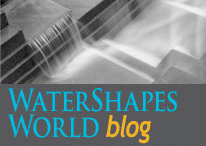ARTICLES
Advance Search
Aquatic Health
Aquatic Health, Fitness & Safety
Around the Internet
Aquatic Culture
Aquatic Technology
Artful Endeavors
Celebrity Corner
Life Aquatic
Must-See Watershapes
People with Cameras
Watershapes in the Headlines
Art/Architectural History
Book & Media Reviews
Commentaries, Interviews & Profiles
Concrete Science
Environment
Fountains
Geotechnical
Join the Dialogue
Landscape, Plants, Hardscape & Decks
Lighter Side
Ripples
Test Your Knowledge
The Aquatic Quiz
Other Waterfeatures (from birdbaths to lakes)
Outdoor Living, Fire Features, Amenities & Lighting
Plants
Ponds, Streams & Waterfalls
Pools & Spas
Professional Watershaping
Structures (Editor's Notes)
Travelogues & History
Water Chemistry
WaterShapes TV
WaterShapes World Blog
Web Links
Around the Internet
Aquatic Culture
Aquatic Technology
Artful Endeavors
Celebrity Corner
Life Aquatic
Must-See Watershapes
People with Cameras
Watershapes in the Headlines
I've noticed through the years that, from my perspective at least, some of my favorite projects come with the best stories. The poolscape seen here is definitely one of these. The client started things off by purchasing a house in an ultra-high-end neighborhood, then personalized it with all sorts of details, materials and finishes that turned the existing house into an extremely comfortable Country French-style estate. The one element it lacked, he figured, was a nice swimming pool. While he was considering his options, the home next door - one with
‘Perception is reality,’ observed Brian Van Bower at the head of his Aqua Culture column for August 2003. ‘Regardless of whether that’s right or wrong, you are judged by appearances.’ ‘If your own appearances mean ugly-looking vehicles, sloppy-looking employees, shabby offices and job sites that look like disaster areas, you will inevitably be judged with that image by the clients who have hired you and by anyone else exposed to
It started as a trickle and then became a flood unlike anything I've witnessed in more than 30 years of focusing on watershapes. Almost every spring since 1986, I've encountered photo features in magazines (and now on web sites) purporting to cover either
As reported in my July 11 blog, I've recently spent the best part of four weeks flat in bed, nursing my way through epic lower-back spasms that at one point sent me to the emergency room. I am delighted to report that I am mostly recovered and am spending more time at
I spent most of the month of June 2018 flat on my back, laid low by spasms in my lower spine so intensely painful that, after several hours of agony, I ended up taking an ambulance to the emergency room. Needless to say, the forced recuperation put a
From time to time, I'll come across a fountain or waterfeature where jets or streams of water are used to suggest "motion" on the part of an accompanying fixed object. The objects in question are typically made of stone or metal - that is, materials embodying solidity, heft, timelessness and the utter absence of motion.
Many years ago, as one example, we published an article by frequent WaterShapes contributor Randy Beard, who wrote about a composition he worked on in which a platform of flowing water at the base of a sculpture of a breaching whale served to suggest it had recently broken the water's surface (click here). And one of my all-time favorites is the galloping-horse sculpture in Dallas, where the hooves of some in the line of dashing equine splendor raise splashes from a stream they're crossing (click here).
A half-dozen other examples of fountains of this type also come quickly to mind, but you get the idea. Done well, this is a cool, softening, naturalizing, communicative, engaging approach - and it gets even better when you're just walking along the street and happen to catch the offered illusion at a favorable angle.
That happened to me not long ago on a visit to San Diego, Calif., where I was walking along and minding my own business when I came across "Bow Wave," a fountain in which the business end of a big ship plies its way through water washing along its flanks. At a glance, it suggests the abundant thrust of a ship's passage as well as the massive resistance it had to overcome to make any headway.
From most angles, you can see that the ship is cut off a short distance back of the bow, but I first saw it in such a way that the leading edge of the sculpture was coming right at me (pretty much at the same angle seen in the image above). It's quite a nice illusion when it catches you off guard - and a slightly startling one at that.
Designed and sculpted by Malcolm Leland and installed in San Diego's Civic Center Plaza in 1972, the composition does a wonderful job in its suggestion of motion; in fact, it's among the best I've ever seen. Its success, alas, reminds me of the horror I felt when I saw that the fountain basin for "The Runner" had been insensitively redesigned in St. Louis: There, the entire, previously successful illusion of motion was cut off by thoughtless jet placement (click here); in San Diego, by contrast, Leland got it just right.
The sculptor was something of a local celebrity in San Diego, but I can find no other instances in which he put his elemental skill as a watershaper to use in any way. That's a pity, because he certainly knew how to put that medium to good use - simple, but effective.
San Diego's not a big town. The next time you're there for business or pleasure, wander by the Civic Center Plaza and be prepared for a nautical treat.
‘Although my business now focuses on design and consulting,’ declared Brian Van Bower near the top of his Aqua Culture column of June 2003, ‘I spent enough years as a contractor to be able to evaluate what goes on between contractor and clients.’ ‘In fact,’ he added, ‘in my role as designer, clients often turn to me with comments about their contractors – and they’re not shy about complaining or in telling me about what makes them happy. And it works the other way, too, because contractors, knowing that I have experience as a contractor myself, will often turn to me as someone who can
Picture this: A seaside fountain in which jets of water are arrayed and programed to emulate a Pacific Ocean swell. It's designed as a mirror to existing conditions, using real-time ocean-observation data to determine the exact timing and height of the fountain's jet sequence. Or this: An installation scheduled by its managers to function as an interactive-play fountain at certain times of the day when children are likeliest to be present, or as a musical/performing fountain in the evenings or at other times when the property owner's desire is to entertain and help people relax. Or this: A fountain that
If you're like me and see life as a weird balance of the tragic and the comic, I have a couple stories tailor-made for you. First the comic - and forgive me for its reference to a component of male anatomy: "When the Dutch city of Leeuwarden


















